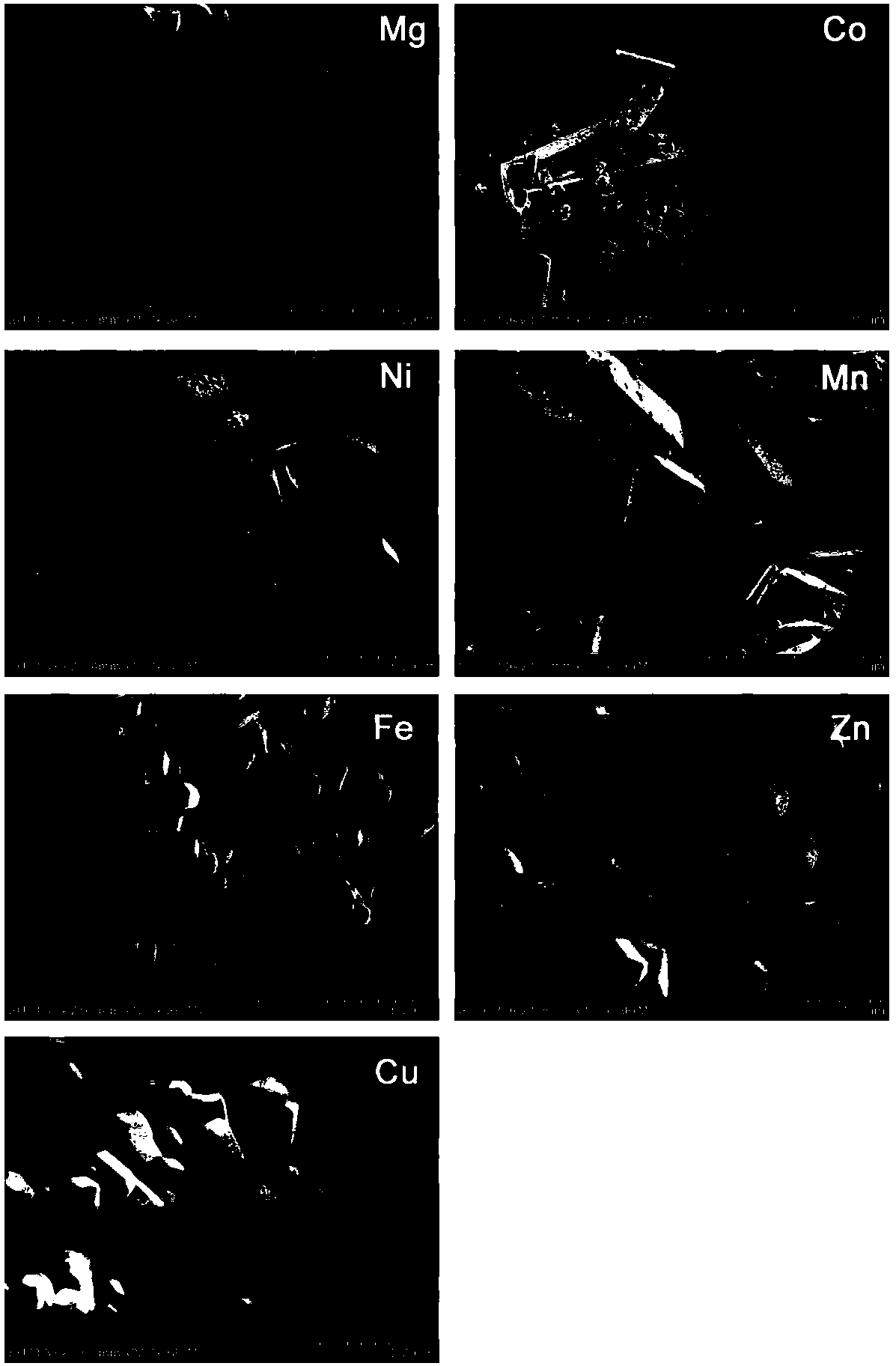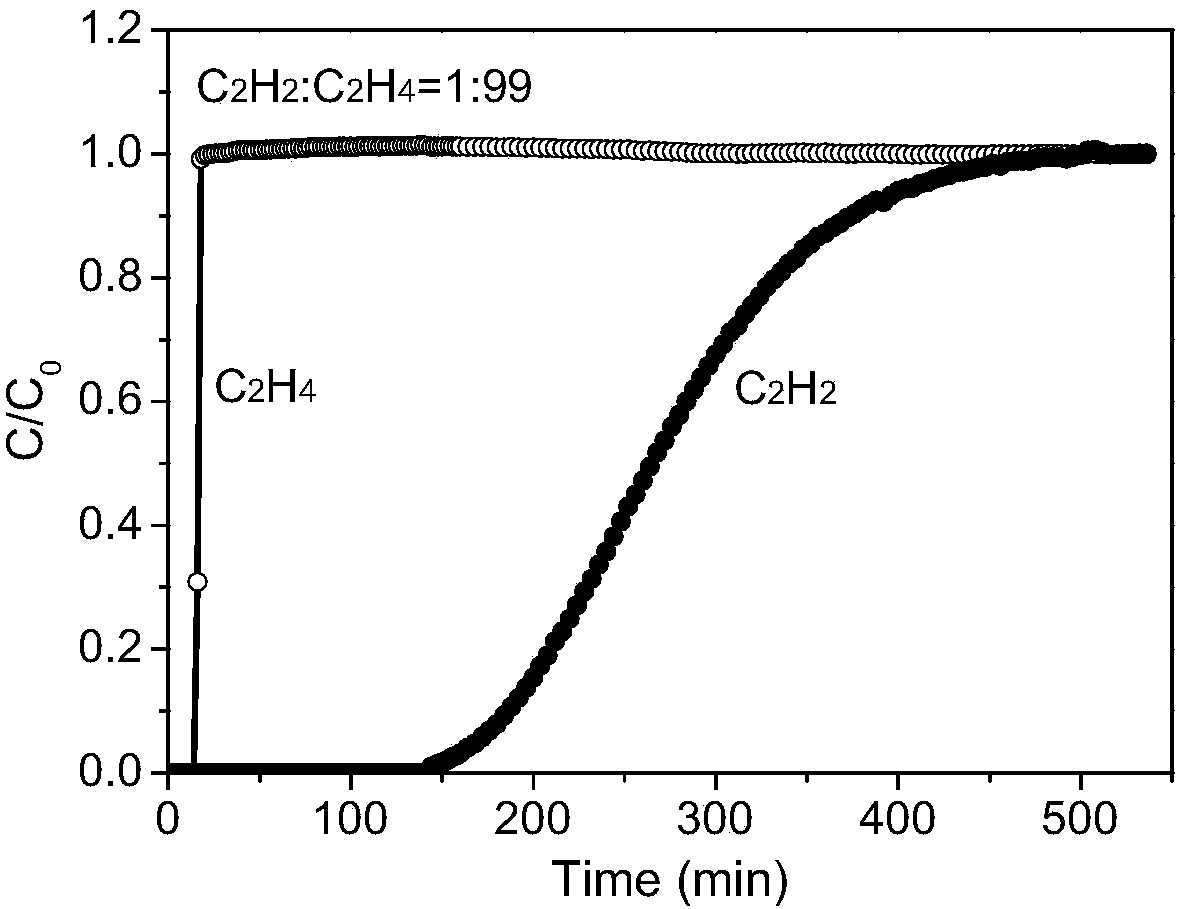Method for separating ethylene and acetylene from mixed gas
A mixed gas and ethylene technology, applied in chemical instruments and methods, adsorption purification/separation, organic chemistry, etc., can solve the problems of a large amount of organic waste liquid, expensive ligands, high preparation costs, etc., and achieve high adsorption selectivity, The effect of low raw material price and low material synthesis cost
- Summary
- Abstract
- Description
- Claims
- Application Information
AI Technical Summary
Problems solved by technology
Method used
Image
Examples
Embodiment 1
[0039] Mix 2mmol of anhydrous magnesium chloride, 4mmol of gallic acid, 5mmol of potassium hydroxide, and 10ml of deionized water, put them in a 25mL hydrothermal reactor, stir for 30 minutes, and then heat to 120°C for 24 hours of reaction. After the reaction is completed, after the reaction kettle is cooled, the solid obtained by the reaction is washed with water and washed with ethanol several times to obtain a purified metal organic framework material. The purified adsorbent is vacuum degassed at 120° C. for 24 hours to obtain a solvent-free adsorbent, which is then subjected to gas adsorption.
[0040] In order to test the adsorption and separation performance of the above-mentioned synthesized metal organic framework material, the single-component adsorption isotherm of ethylene acetylene was performed using the above-mentioned adsorbent. Take an appropriate amount of adsorbent, and the adsorption temperature is 25 degrees. After testing, at 25℃ and 1bar, the adsorption ca...
Embodiment 2
[0044] Mix 2mmol of cobalt chloride hexahydrate, 4mmol of gallic acid, 1.6mmol of potassium hydroxide, and 10mL of deionized water, put them into a 25mL hydrothermal reactor, stir for 30 minutes, and react at 120°C for 24 hours. After the reaction is completed, it is cooled, and washed with water and ethanol three times to obtain a purified metal organic framework material. The purified adsorbent is vacuum degassed at 120°C for 24 hours to obtain a solvent-free adsorbent, which is then subjected to gas adsorption.
[0045] In order to test the adsorption and separation performance of the above-mentioned synthesized metal organic framework material, the single-component adsorption isotherm of ethylene acetylene was performed using the above-mentioned adsorbent. Take an appropriate amount of adsorbent, and the adsorption temperature is 25 degrees. After testing, at 25℃ and 1bar, the adsorption capacity of acetylene is as high as 3.78mmol / g, and the adsorption capacity of ethylene ...
Embodiment 3
[0049] Mix 2mmol of nickel chloride hexahydrate, 4mmol of gallic acid, 1.6mmol of potassium hydroxide, and 10mL of deionized water, put them in a 25mL hydrothermal reactor, stir for 30 minutes, and react at 120°C for 24 hours. After the reaction is completed, the reactor is cooled, and washed with water and ethanol three times to obtain a purified metal organic framework material. The purified adsorbent is vacuum degassed at 120° C. for 24 hours to obtain a solvent-free adsorbent, which is then subjected to gas adsorption.
[0050] In order to test the adsorption and separation performance of the above synthesized metal organic framework material, the single-component adsorption isotherm of ethylene acetylene was performed using the above adsorbent. Take an appropriate amount of adsorbent, and the adsorption temperature is 25 degrees. After testing, at 25℃ and 1bar, the adsorption capacity of acetylene is as high as 3.01mmol / g and the adsorption capacity of ethylene is only 1.83...
PUM
| Property | Measurement | Unit |
|---|---|---|
| adsorption capacity | aaaaa | aaaaa |
| adsorption capacity | aaaaa | aaaaa |
| adsorption capacity | aaaaa | aaaaa |
Abstract
Description
Claims
Application Information
 Login to View More
Login to View More - R&D
- Intellectual Property
- Life Sciences
- Materials
- Tech Scout
- Unparalleled Data Quality
- Higher Quality Content
- 60% Fewer Hallucinations
Browse by: Latest US Patents, China's latest patents, Technical Efficacy Thesaurus, Application Domain, Technology Topic, Popular Technical Reports.
© 2025 PatSnap. All rights reserved.Legal|Privacy policy|Modern Slavery Act Transparency Statement|Sitemap|About US| Contact US: help@patsnap.com



